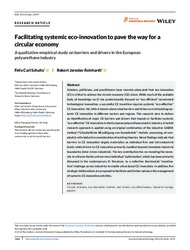Facilitating systemic eco‐innovation to pave the way for a circular economy: A qualitative‐empirical study on barriers and drivers in the European polyurethane industry
DOI: https://doi.org/10.1111/jiec.13299
Persistent URL: http://resolver.sub.uni-goettingen.de/purl?gldocs-11858/10469
Persistent URL: http://resolver.sub.uni-goettingen.de/purl?gldocs-11858/10469
Schultz, Felix Carl; Reinhardt, Robert Jaroslav, 2022: Facilitating systemic eco‐innovation to pave the way for a circular economy: A qualitative‐empirical study on barriers and drivers in the European polyurethane industry. In: Journal of Industrial Ecology, Band 26, 5: 1646 - 1675, DOI: 10.1111/jiec.13299.
 |
Dokument öffnen: |
Scholars, politicians, and practitioners have recently advocated that eco‐innovation (EI) is critical to achieve the circular economy (CE) vision. While much of the available body of knowledge on EI has predominantly focused on “eco‐efficient” incremental technological innovation, a successful CE transition requires systemic “eco‐effective” CE innovation. Yet, little is known about what barriers and drivers are stimulating systemic CE innovation in different sectors and regions. This research aims to deliver an identification of major CE barriers and drivers that impede or facilitate systemic “eco‐effective” CE innovation in the European polyurethane plastics industry. A hybrid research approach is applied using an original combination of the inductive GABEK method (“GAnzheitliche BEwältigung von Komplexität”—holistic processing of complexity) with deductive consideration of existing theories. Novel findings indicate that barriers to CE innovation largely materialize on individual firm and intra‐industrial levels, while drivers to CE innovation primarily manifest beyond immediate industrial boundaries (inter‐/cross‐industrial). The key contribution lies on revealing the necessity to reframe the focus from mere individual “optimization”, which has been primarily discussed in the contemporary EI literature, to a collective (horizontal) “coordination” challenge across industries to enable a functional CE innovation. In addition, five strategic deliberations are proposed to facilitate and further advance the management of systemic CE innovation activities.
Statistik:
ZugriffsstatistikSammlung:
Schlagworte:
circular economyeco‐innovation
barriers and drivers
eco‐effectiveness
industrial ecology
plastics
This is an open access article under the terms of the Creative Commons Attribution License, which permits use, distribution and reproduction in any medium, provided the original work is properly cited.

